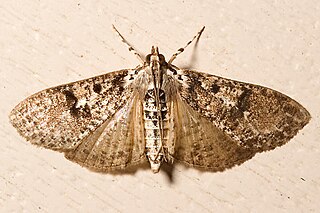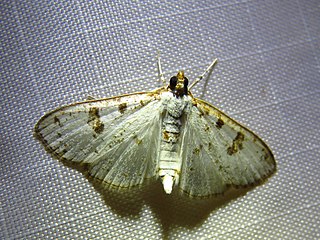Xanthophysa is a monotypic moth genus of the family Crambidae described by Eugene G. Munroe in 1964. It contains only one species, Xanthophysa psychialis, the xanthophysa moth, described by George Duryea Hulst in 1886. It is found in North America, where it has been recorded from Alabama, Florida, Illinois, Indiana, Kentucky, Maine, Mississippi, New Hampshire, New Jersey, North Carolina, Ohio, Ontario, Quebec, South Carolina and Tennessee.

Palpita arsaltealis is a moth of the family Crambidae first described by Francis Walker in 1859. It is found in the north-eastern United States, south to South Carolina. It is also present in Quebec and Ontario.
Elophila atlantica is a moth in the family Crambidae. It was described by Eugene G. Munroe in 1972. It is found on North America, where it has been recorded from Nova Scotia, Florida, Maine, Maryland and South Carolina.

Petrophila canadensis, the Canadian petrophila moth, is a moth in the family Crambidae. It was described by Eugene G. Munroe in 1972. It is found in North America, where it has been recorded from southern Canada and the north-eastern United States.
Microcrambus discludellus is a moth in the family Crambidae. It was described by Heinrich Benno Möschler in 1890. It is found in the Dominican Republic, Puerto Rico and Colombia, as well as in North America, where it has been recorded from Florida and South Carolina.
Orenaia macneilli is a moth in the family Crambidae. It was described by Eugene G. Munroe in 1974. It is found in North America, where it has been recorded from California.
Lipocosma septa, the exposed lipocosma moth, is a moth in the family Crambidae. It was described by Eugene G. Munroe in 1972. It is found in North America, where it has been recorded from Florida, Georgia, Maryland, North Carolina, Oklahoma, South Carolina, Texas and Virginia.
Anania leuschneri is a moth in the family Crambidae. It was described by Eugene G. Munroe in 1976. It is found in North America, where it has been recorded from South Carolina and Florida.
Crocidophora pustuliferalis is a moth in the family Crambidae. It was described by Julius Lederer in 1863. It is found in North America, where it has been recorded from Alabama, Arkansas, Florida, Indiana, Maryland, New Mexico, North Carolina, Oklahoma and South Carolina.

Crocidophora tuberculalis, the pale-winged crocidiphora moth, is a moth in the family Crambidae. It was described by Julius Lederer in 1863. It is found in North America, where it has been recorded from Alabama, Florida, Georgia, Illinois, Indiana, Maine, Maryland, Massachusetts, Mississippi, New Hampshire, North Carolina, Ohio, Oklahoma, Ontario, Quebec, South Carolina, Tennessee, Texas, Virginia, West Virginia and Wisconsin.

Pyrausta arizonicalis is a moth in the family Crambidae. It was described by Eugene G. Munroe in 1976. It is found in North America, where it has been recorded from Texas, New Mexico and Arizona.

Pyrausta pseudonythesalis, the Shasta pyrausta moth, is a moth in the family Crambidae. It was described by Eugene G. Munroe in 1976. It is found in North America, where it has been recorded from California, Nevada, Arizona, New Mexico and Texas.
Scoparia dominicki is a moth in the family Crambidae. It was described by Eugene G. Munroe in 1972. It is found in North America, where it has been recorded from Florida, North Carolina, Oklahoma, South Carolina and West Virginia.
Noctueliopsis atascaderalis is a moth in the family Crambidae. It was described by Eugene G. Munroe in 1951. It is found in North America, where it has been recorded from California.
Diastictis pseudargyralis is a moth in the family Crambidae. It was described by Eugene G. Munroe in 1956. It is found in North America, where it has been recorded from Florida, South Carolina and West Virginia.

Palpita aenescentalis is a moth in the family Crambidae. It was described by Eugene G. Munroe in 1952. It is found in North America, where it has been recorded from Illinois, Indiana, Maine, Maryland, North Carolina, North Dakota, Ohio, Oklahoma, Ontario, Quebec, South Carolina, Tennessee, Virginia and Wisconsin.
Palpita kimballi, or Kimball's palpita moth, is a moth in the family Crambidae. It was described by Eugene G. Munroe in 1959. It is found in North America, where it has been recorded from Alabama, Florida, Georgia, Louisiana, North Carolina, Oklahoma, South Carolina, Tennessee and Virginia.
Palpita persimilis, the olive shootworm moth, is a moth in the family Crambidae. It was described by Eugene G. Munroe in 1959. It is found in Santa Catarina, Brazil.
Palpita cincinnatalis is a moth in the family Crambidae. It was described by Eugene G. Munroe in 1952. It is found in North America, where it has been recorded from Florida, Illinois and Ohio.

Palpita illibalis, the inkblot palpita moth, is a moth in the family Crambidae. It was described by Jacob Hübner in 1818. It is found in North America, where it has been recorded from Alabama, Florida, Georgia, Maryland, Mississippi, North Carolina, Ohio, Oklahoma, Pennsylvania, South Carolina, Tennessee, Virginia and West Virginia.








